Language-based models have changed the way humans operate, & AI-powered chatbots have become a well-known method for businesses to communicate with clients. Since 2021, Microsoft launched an OpenAI tool (ChatGPT) which has been gaining tremendous popularity and growth.
So, how can Google stay behind?
Recently, Google unveiled Bard, its AI chat service, in direct opposition to Open AI’s ChatGPT.
Bard tool is launched to compete with ChatGPT. However, ChatGPT and Google Bard have the exact working mechanism but differ in one parameter or two.
So, let’s take a deep insight into this comprehensive guide on what is chatgpt, google bard, and the differences between ChatGPT and Google Bard.
Google Bard vs. ChatGPT
ChatGPT is an AI-powered chatbot system designed and developed by OpenAI. It is part of OpenAI’s GPT (Generative Pre-trained Transformer) series of language models trained on a large corpus of text data that generates human-like responses to a given prompt.
 Features of ChatGPT
Features of ChatGPT
- Natural language processing
- Question answering
- Language translation
- Conversation and summarization
- Sentimental analysis
Although GPT is renowned for its capacity to produce writing that is both logical and contextually appropriate, it may also occasionally generate text that is prejudiced or incomprehensible.
Google Bard, launched on February 6, 2023, is another AI-powered Chatbot which is developed by Google. This tool is a conversational AI chatbot that uses Google’s LaMDA (Language Model for Dialogue Applications) to compete with Microsoft-backed firm OpenAI.
 Features of Google Bard
Features of Google Bard
Since the algorithm incorporates a state-of-the-art language model, it has several notable features, including:
- Human-like-text generation
- Fast interference speed
- Integration with google cloud
- Pre-training on diverse data
- Customization and fine-tuning
GPT (Generative Pre-trained Transformer)
 GPT is a quantifiable programming-based language model that employs word grouping. It can generate artificial intelligence-generated text that is distinct from what a human can produce in segments, sentences, articles, talks, short stories, and verses for a poem. The program has been programmed to take instructions as a prompt and respond with a detailed answer. OpenAI’s recent announcements of ChatGPT employ the third iteration of GPT, known as GPT-3.
GPT is a quantifiable programming-based language model that employs word grouping. It can generate artificial intelligence-generated text that is distinct from what a human can produce in segments, sentences, articles, talks, short stories, and verses for a poem. The program has been programmed to take instructions as a prompt and respond with a detailed answer. OpenAI’s recent announcements of ChatGPT employ the third iteration of GPT, known as GPT-3.
ChatGPT may be adjusted for different natural language processing tasks, such as question answering, translation, and text summarization. It uses the language model of GPT-3 in which its data is trained on more than 2 billion parameters to retrieve information & formulate responses to users’ queries.
The AI tool is designed for natural languages processing tasks such as conversation and text generation & can be fine-tuned for specific tasks or used to generate text responses in a conversational setting.
LaMDA (Language Model for Dialogue Applications)
LaMDA is an artificial intelligence that analyzes human speech and recognizes commands in it. Voice assistants Siri and Alexa work on a similar principle and technology for creating real-time subtitles. According to Google, Bard AI has been released with LaMDA (a lightweight model version) that utilizes less computing power, allows scalability to more users & gaining more feedback that is intended to be combined with Google’s own internal testing.
LaMDA is essentially a statistical method that can predict the following words in a series based on the previous ones. It allows the conversation to flow freely from one topic to another & utilizes concepts like multimodal user intent, reinforcement learning, and suggestions.
According to Google, Bard can complete multiple tasks, including text production, question-answering, and summarization & aspires to bring together the breadth of human knowledge with the power, humor, and creativity of its vast language models.
The Financial Times reports that Google has contributed $300 million to Anthropic, a well-known OpenAI opponent. Google Bard is presently undergoing testing, and the whole public will be able to use it in a few weeks. Bard is currently in beta testing, meaning modifications and enhancements are in the works.
Google Bard vs. ChatGPT : A Comparative Analysis
Even though Bard and ChatGPT are both language-based conversational AI models & have the same working mechanism Still, there might be a slight difference between the ChatGPT app and Google Bard in their intended applications and architecture.
| S.No. | Basis | ChatGPT | BARD |
| 1 | Created Or Innovated By | Innovated by Open Al | Created by Google |
| 2 | Language Model | Build on OpenAI’s GPT-3 | Build on Google’s LaMDA |
| 3 | Source Of Information | Data feed | Internet |
| 4 | Release Date | 7 February 2023 | 30 November 2022 |
| 5 | Available On | Bing search engine | Google search engine |
| 6 | Based On | Reinforcement learning from Human Feedback model | Based on transformer & is trained on dialogues |
| 7 | Information Model | Offline Model—data available till 2021 & doesn’t have live web data | Online model—takes info from web |
| 8 | Access | Unlimited (20$ for upgraded version right now in USA only) | Limited (Access for limited users only till now) |
| 9 | Uses | Explain complex concepts, assist in basic search functions, provide ideas, etc. | Explanation & language translation along with what’s not imagined. |
| 10 | Plagiarism Detector | No plagiarism detector | Has plagiarism detector |
In a series of tweets and on Google blogs, CEO Sundar Pichai described the idea behind Bard that it’ll be a direct competitor to OpenAI’s ChatGPT. —“Coming soon: Bard, a new experimental conversational #GoogleAI service powered by LaMDA,” the CEO mentioned in a tweet.
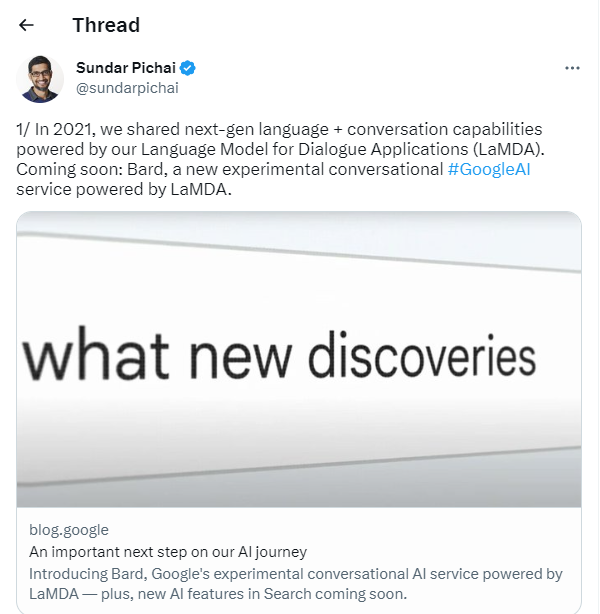
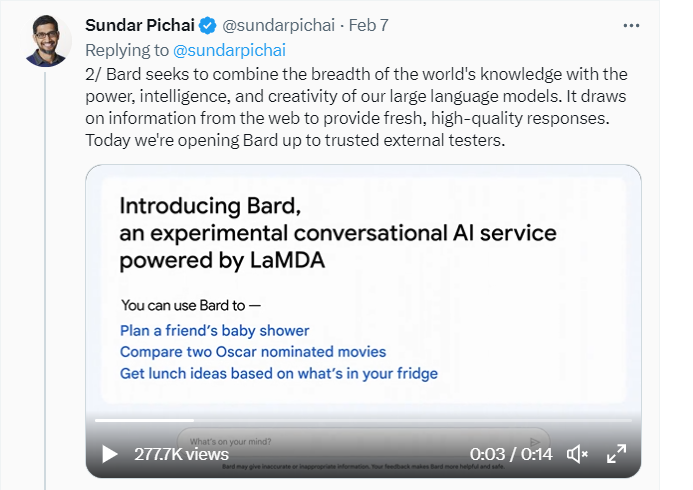
Google Bard vs. ChatGPT: Pros And Cons
Compared to OpenAI’s ChatGPT, Google Bard AI offers unique benefits — its output is contextually appropriate & high-quality. But regarding creativity and uniqueness of text generation, some drawbacks should be considered, limiting users from achieving certain results in their applications. In contrast, ChatGPT’s vast corpus of available data and ability to effectively generate human-like texts across multiple styles and formats make it the optimal choice for those seeking creative solutions or chatbot scenarios.
Although ChatGPT has its own advantages, it still comes with some limitations. For instance, those who lack tech knowledge may struggle to get the most out of this modern AI technology due to it’s excessive learning curve. Moreover, there are circumstances when the output generated by ChatGPT could be off-topic and irrelevant to the initial prompt.
 Pros of ChatGPT: Pros of ChatGPT:
|
 Cons of ChatGPT: Cons of ChatGPT:
|
 Pros of Bard AI: Pros of Bard AI:
|
 Cons of Bard AI: Cons of Bard AI:
|
Google Bard vs. ChatGPT: Similarities
These are some of the common characteristics between OpenAI’s ChatGPT & Google’s language models. Both OpenAI’s & Google’s language models share some common features, which include:
- Natural language generation: Both models are designed to generate high-quality, human-like text based on a given prompt.
- Pre-training: Both models are pre-trained on large datasets to learn the patterns and relationships between words, phrases, and sentences.
- Transfer learning: Both models can be fine-tuned for specific tasks and domains, allowing for more specialized and personalized responses.
- Advancements in AI: Both models represent significant advancements in the field of artificial intelligence and natural language processing.
Both bard & chatgpt has the potential to transform the way that businesses use and interact with AI, and both are examples of the exciting modern developments taking place in the field of AI.
Google Bard vs. ChatGPT: Differences
Let’s discover some of the key differences between OpenAI’s language models and Google’s language models:
1- Google Bard vs. ChatGPT: Size
With billions of parameters, OpenAI’s language models, like GPT-3, are among the biggest AI models ever created. Comparatively speaking, Google’s language models, like Bard’s, are more compact but can still produce excellent text.
2- Google Bard vs. ChatGPT: Integrations
Both the OpenAI tool – Chatbot, and Google AI tool – Bard, want their respective Chatbots integrated within their ecosystem. The OpenAI’s tool, i.e., ChatGPT, is already integrated with Bing and Teams.
Conversely, Google’s Bard AI Chatbot will soon be integrated into Google search. Like Bing, it will enable users to search by asking questions with the AI-powered Chatbot rather than through the traditional search bar.
Besides this, Google has also rolled out AI-based tools into Maps and Lens, though they aren’t the integrations of Bard. However, it will allow third-party developers to utilize Bard.
3- Google Bard vs. ChatGPT: Training Data
OpenAI’s models are trained on various texts from the internet, including articles, websites, and social media posts. Google’s AI models are trained on a similar but slightly different range of texts, which can result in differences in the type and quality of responses generated by each model.
4- Google Bard vs. ChatGPT: Reliable Information
Bard will use currently available online material, including statistics and sources. Google Bard will have access to the most recent date and will be able to deliver more up-to-current information, whereas Chat GPT’s knowledge is restricted to the events through 2021. Bard AI will have access to a wealth of data and be integrated with Google’s search engine, providing it an advantage against Chat GPT, which is supported by Microsoft.
5- Google Bard vs. ChatGPT: Objective
Bard can break up complex ideas into bite-sized, conversation-starting fractions. The objective is to communicate information more broadly in an understandable way and may inspire everyone, especially children, to learn. Chat GPT, on the other hand, produces material in response to the text prompt.
6- Google Bard vs. ChatGPT: Prices & Availability
Both the AI-based tool (ChatGPT and Bard) are free to use. Currently, ChatGPT provides a free research preview on OpenAI’s website. But now, the paid subscription model of ChatGPT is also available as ChatGPT Plus.
On the other hand, Bard only has a freemium model at the moment. But, one has to be a trusted tester to access this Google’s AI-based Chatbot. Some of the features have been announced by Google, such as – Maps and lens, but the Bard tool is still not visible to the public.
7- Google Bard vs. ChatGPT: Performance
OpenAI’s models have been shown to perform well on tasks that require a high degree of understanding and context, such as summarization & question-answering. While still capable of generating high-quality text, Google’s models may have a slightly faster inference speed and lower latency, making them more suitable for real-time applications.
8- Google Bard vs. ChatGPT: Features
Both AI-based tools are somewhat similar, but the features are similar too. The users can simply insert a query in the tool and get an appropriate answer in just a blink of an eye.
The tool provides greater context to answers. This AI-based Chatbot can produce prose to write news articles, fiction poems, product descriptions, blog posts, and more. It can even supply the code necessary to develop a simple website because it can handle several coding languages. Although it’s not improbable that Bard or Bing won’t be able to handle these kinds of requests, these capabilities have not yet been shown.
9- Google Bard vs. ChatGPT: Accessibility
The OpenAI API, which charges for access to the models, makes the models from OpenAI available. On the other hand, Google’s models are incorporated into Google’s cloud platform, giving users easier access and a more integrated experience.
Google Bard vs. ChatGPT: How To Get Started
Google Bard: To get started with Google Bard AI, you’ll need to sign up for an API key & follow the Google documentation. Once you’ve your API key, you can start using Google Bard to generate text.
Or, if you’re a beta tester, you can use the Google AI chatbot from the Google app. Tap on the chatbot icon, enter the prompt, hit enter & here you go.
You can start a chat conversation by asking a complex question or fun fact about anything or making requests. Bard is not widely available for public use yet as it’s in a testing process, but soon Bard will also be accessible to the users, and you will be able to get answers while asking a query.
ChatGPT: To get started with ChatGPT, you will need to install the OpenAI API & follow the OpenAI documentation. Once you’ve installed the API, you can start using ChatGPT to generate text in your applications. Or, you can start using ChatGPT from OpenAI’s official website: https://chat.openai.com/. Here are the steps you can follow:
Step 1: You can sign up for the ChatGPT platform by using an existing email id. It will ask for your mobile number for verification. Once it’s verified, you are ready to go.
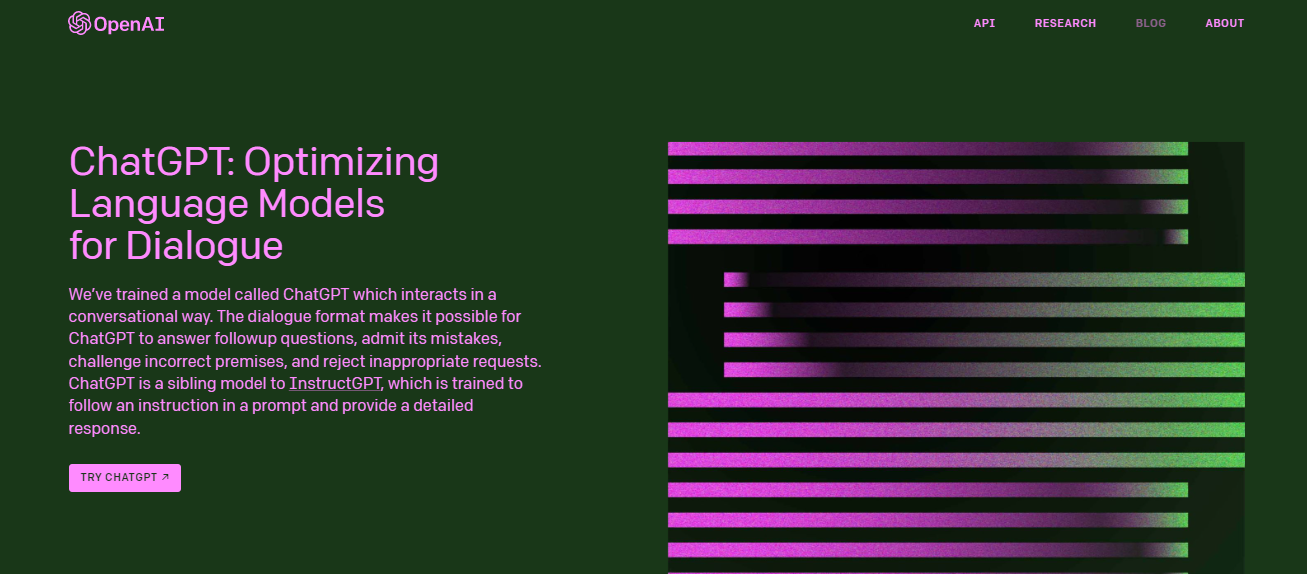
Sometimes, it might be overloaded with requests because many people use it simultaneously.
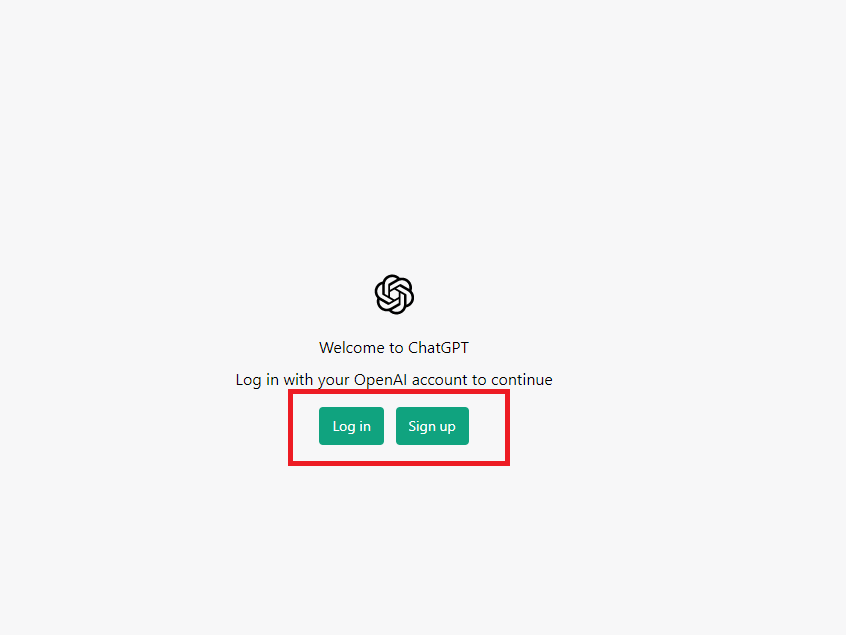
If you cannot create an account now or show a waiting list, you can try again later.
Step 2: Once you log in, you will see a new chat window that gives you the examples, capabilities and limitations of chatGPT. You can start writing your prompt here.
Here you also have the option to choose light mode & dark mode. It’s up to you.
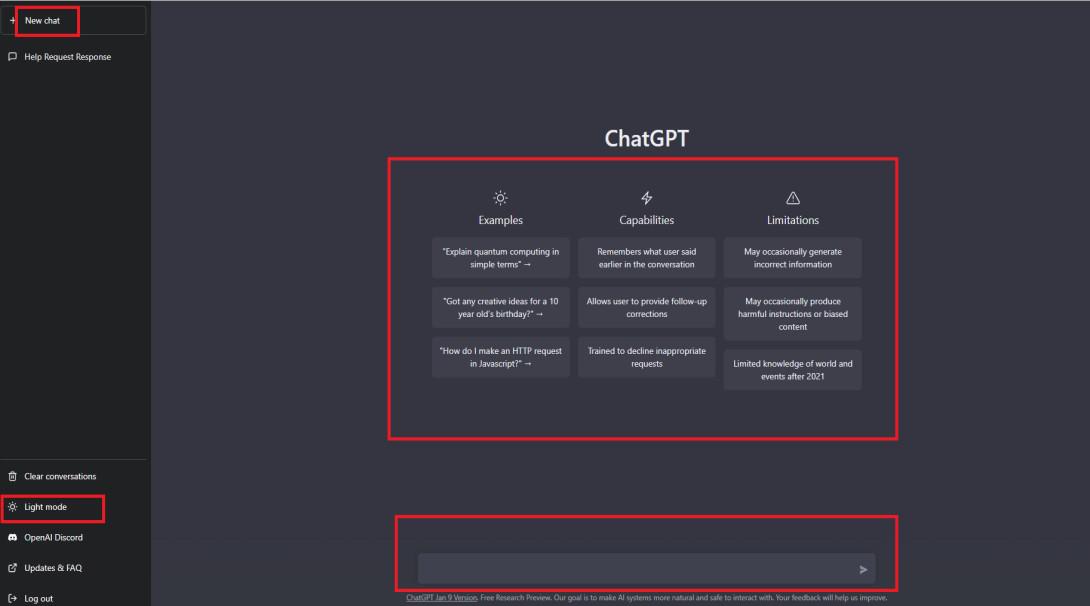
Step 3: Just ask what you want to know, and ChatGPT will come up with smart responses for your reference. We have shared the screenshot for reference of how you can interact using ChatGPT
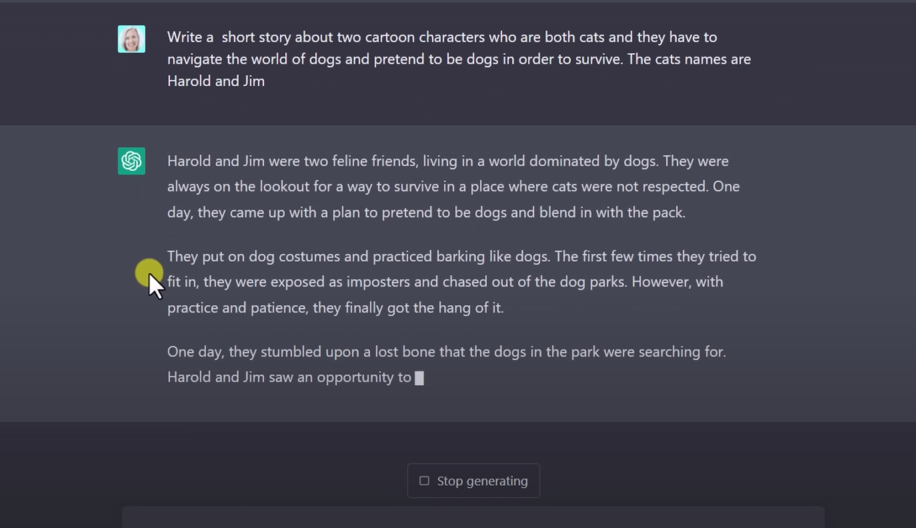
Google Bard vs. ChatGPT: Which AI Model Is Better?
It’s worth noting that both AI models are constantly evolving, and new models and updates are constantly being developed. It’s difficult to say which AI model is “Better” as it depends on the specific task and the desired outcome.
ChatGPT is optimized for conversational AI tasks, such as answering questions and providing information to generate human-like responses. It is well-suited for applications such as Chatbots and question-answering systems.
While Google Bard is designed for creative writing, such as generating poems, stories, and other forms of imaginative text. It has been trained on diverse text data, allowing it to generate coherent and imaginative text.
It fully depends on your requirements. If you’re looking for a model that can provide human-like responses in a conversational context, ChatGPT may be a better option. Bard may be a better choice if you’re looking for a model to generate creative writing.
What AI model will be best for my business growth?
ChatGPT & Google Bard are two of the leading machine learning technologies that offer marketers & businesses tremendous opportunities to gain a competitive edge.
Choosing between ChatGPT & Google Bard is based on individual business needs. Google Bard may be best suited if you’re searching for a platform that can generate insightful text per your input prompt.
On the other hand, if an AI-driven conversational system that provides humanlike texts in unique formats would fit better into your objectives, consider ChatGPT as an alternative solution.
Ultimately, each product is designed to address different needs, so choosing the one most suited to your business demands is wise. As more and more ML applications become available on the market, understanding the various features and benefits of each will be essential to staying at the forefront of AI-driven tools.
To Sum Up:
So, in conclusion, be it Google’s Bard AI or Microsoft’s ChatGPT, both platforms need to be handled sensitively since this is a realm of technology that could have far-reaching consequences. In this ever-ongoing battle of ChatGPT Vs Google Bard, one thing is for sure that AI development will continue to rise with time and change the lifestyle to a great extent.
Moreover, you must be careful while using these AI tools because they may sometimes generate inaccurate results. You must read it before posting it anywhere online; otherwise, it may affect your business website or profile.
Try it on your own and see the magic of these AI tools. By leveraging the power of these tools, you can take their business project campaigns to the next level and achieve greater success in your journey. Need help in growing more website traffic & sales? Reach out to our expert digital marketers now & level up your brand to the next level.
Need more tips & information for your business ranking, branding, and marketing? Visit our blog section now. There you’ll find a lot of useful tried & tested advice and insights into different areas of the online world – from SEO to ecommerce to web design & more. Check out our blogs, or get in touch for expert advice.
 Happy Learning!
Happy Learning!
The post Google Bard vs. ChatGPT: Everything We Know appeared first on DigitalGuider.
Source: digitalguider.com

